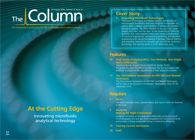ARC Announce New Partnership with Wasson-ECE
Activated Research Company (ARC), producers of the Polyarc reactor, has announced a new partnership with Wasson-ECE to bring the system to the international market for the first time.
Activated Research Company (ARC) (Minnesota, USA), producers of the Polyarc reactor, has announced a new partnership with Wasson-ECE (Colorado, USA) to bring the system to the international market for the first time.
The Polyarc reactor is a catalytic microreactor designed to enhance gas chromatography (GC) with a flame ionization detector (FID) by converting organic compounds to methane prior to detection. A recent publication in The Analyst demonstrated the reaction of trimethylsilylated chemical analytes to methane using this system (1).
“Combining our private label version of the Polyarc reactor system with our core chromatography technology allows us to expand our portfolio of solutions, which will greatly benefit our customers,” said John Wasson, President of Wasson-ECE. “There are many applications of the device and we look forward to integrating it into new and existing GC solutions as well as being ARC’s global distribution channel,” he continued.
This collaboration sees Wasson-ECE become the distributor for this catalytic microreactor outside of the US as well as providing technical assistance.
For more information please visit www.activatedresearch.com and www.wassonece.com
Reference
- C. Beach et al., Analyst141, 1627–1632 (2016).

Removing Double-Stranded RNA Impurities Using Chromatography
April 8th 2025Researchers from Agency for Science, Technology and Research in Singapore recently published a review article exploring how chromatography can be used to remove double-stranded RNA impurities during mRNA therapeutics production.
The Effect of Time and Tide On PFAS Concentrations in Estuaries
April 8th 2025Oliver Jones and Navneet Singh from RMIT University, Melbourne, Australia discuss a recent study they conducted to investigate the relationship between tidal cycles and PFAS concentrations in estuarine systems, and offer practical advice on the sample preparation and LC–MS/MS techniques they used to achieve the best results.










